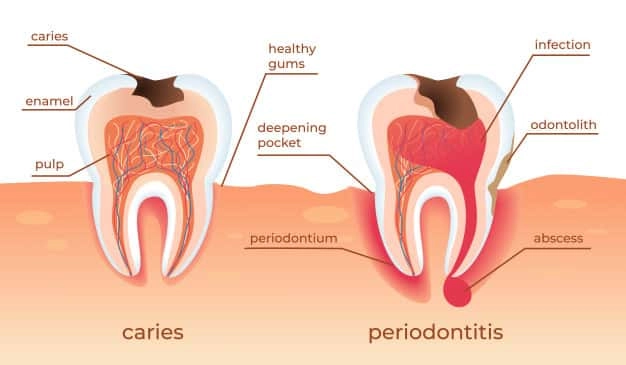Advanced gum disease, called periodontitis, affects many people all around the world. As common as the condition is, tooth loss is often the unfortunate outcome when left untreated.
Read on to learn about periodontology treatment.
But today, with so many successful treatment options available for advanced periodontal disease, losing teeth doesn’t have to be your next step with an unhealthy gumline.

Gum disease is a sneaky, progressive disease, and here’s why: The first stage, called gingivitis, occurs when bacterial plaque is not thoroughly removed from your teeth. Red, swollen and bleeding gums are the telltale signs of this infection. However, this condition is easily reversible with daily brushing and flossing – and a professional cleaning at the dentist’s office.
When left untreated, however, gingivitis can progress into a more serious condition called periodontitis. Toxins from this buildup of bacterial plaque not only affect your gum tissue, but also the bone and ligaments that support your teeth. As the infection causes disease to the bone and supporting tissues, your teeth may eventually fall and need to be treated surgically or removed.
Your first step in treating periodontitis is a conservative, nonsurgical treatment called scaling and root planing (SRP). A dentist or dental hygienist provides this treatment by scraping and removing the plaque and tartar off of your teeth and root surfaces by scaling, and then smoothing away any roughness on the roots to prevent bacteria from gathering again.
After this process, the gums will heal and reattach themselves to the healthy, clean surfaces of the teeth. Within a few weeks, your dentist will evaluate your healing and decide if further treatment is necessary.
Anyone who has had treatment for advanced periodontal disease knows that meticulous homecare is the key to keeping periodontal disease from rearing its ugly head again. Because personal oral care is a big part of any periodontal treatment plan, your dentist or dental hygienist will spend lots of time with you making sure you understand and implement proper brushing and flossing techniques at home. In addition to not smoking, which inhibits the healing process, your dentist will also recommend keeping a close eye on your periodontal health with more frequent checkups and cleaning appointments. When dealing with periodontal disease, “an ounce of prevention is worth a pound of cure.”
Periodontal diseases are inflammatory diseases that affect the tissues that support the teeth and gums. Approximately 70% of tooth loss occurs in adults due to periodontal diseases. When these diseases are diagnosed early, they can be successfully treated.
When gum diseases are treated, natural teeth are protected, a better digestive system is provided and chewing is easier.
Periodontal diseases begin with gingivitis. The gums appear red, bloody and swollen. Gingivitis does not cause any serious discomfort in the early period. But if left untreated, the disease proceeds to periodintitis. This can cause irreversible damage to the alveolar bone that supports the teeth and gums.
Periodontitis is an advanced stage of periodontal diseases. At this stage, the tissues supporting the teeth and the alveolar bone are damaged. The presence of a “periodontal pocket” between the gum and the tooth causes infection and accelerates the progression of the disease. As the disease progresses, the teeth begin to sway. Teeth may have to be pulled out at the end of the disease.
Periodantal disorders or inflammation in the tissues that support the teeth can cause loss of teeth with the progression of the disease. The main treatment in dentistry is periodontal treatment. Complaints such as bleeding gums, displacement of teeth over time, shaking of teeth, changing gums color or gum recession are the disorders in the periodontology field. Patients with these conditions should be treated by a specialist periodontologist.
As a result of the studies, it has been determined that passing the periodontologist examination before making the prosthesis prolongs the life of the prosthesis.
The most important cause of gum disease is the colorless and sticky layer on the teeth called dental plaque. This layer should be removed with daily brushing and flossing. If the plaques are not effectively cleaned, they turn into a structure known as tartar. Plaques cause damage to the teeth and the fibers that connect the tooth to the gum are damaged. Thus, periodontal pocket is formed. This makes it easier for bacteria to reach the deeper tissues. As the disease progresses, the bacteria go deeper. Bacterial progression to the bone causes great damage to the alveolar bone that supports the teeth. If the disease is not treated, the teeth begin to sway and the tooth may need to be removed.
Early treatment of gum disease involves cleaning the plaque and tooth stones in the teeth and ensuring the smooth root surface. With this process, bacteria that cause infection in the gums are removed. If paying attention to the patient’s oral hygiene after the treatment, it is prevented to see a gingival discomfort again.
In more advanced cases, surgical treatment may be required. This treatment is to clean the dental stones in the deep periodontal pockets surrounding the teeth, to form an easily cleanable gingiva form, to provide a smooth root surface and the elimination of the pocket.
It is very important that the patient pays attention to daily oral care so that the disease does not reoccur after periodontal treatment.

